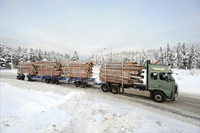Extra long timber haulage combination tested successfully

The ETT (En Trave Till or ‘One More Pile’) project has been in progress in northern Sweden for two years now. The project’s aim is to find ways to rationalise timber haulage and using a 30-metre long Volvo combination with a payload of 66 tonnes plays a central role. If this type of combination were to become standard, fuel consumption from timber haulage would be reduced by an impressive 20 per cent, according to a new report.
Överkalix in northern Sweden is covered with thick snow. The cold is biting. Sanna Brännholm looks on as the cargo is loaded onto Europe's longest truck combination used for scheduled runs. She gazes up at the enormous piles of timber.
“I was a bit nervous before driving the combination for the first time. But this will be my twentieth run, and it’s second nature now,” she says before climbing into the Globetrotter cab and starting the 90 tonne truck.
The truck is being used in the ETT (or ‘One More Pile’) project, which is aimed at finding ways of rationalising timber haulage. It is a collaboration between various players with interests in the Swedish timber industry, but Volvo Trucks is co-ordinating the project.
“But above all, we’ve provided all the technology and developed the whole vehicle concept,” explains Lena Larsson, project manager at Volvo Trucks. “The trailer consists of a modular system encompassing a dolly, a link and a semi-trailer, which offers us many combination options."
Out on the road, Brännholm waves at an oncoming timber truck. Her odometer shows 544,286 kms. The truck, a Volvo FH16 with a 660hp engine, has really been worked hard. On 1st January 2011, it had been in operation for exactly two years and during that time, the truck has hauled over 100,000 tonnes of timber between Överkalix and Munksund. A total of eight drivers have driven the vehicle and all are satisfied with its driving properties.
“It’s very comfortable inside and behaves just like any other truck," says Sanna Brännström as she prepares for an uphill section ahead. “It’s important to plan carefully while driving and speed up a bit extra ahead of uphill stretches.”
The project’s progress is being monitored closely in countries, such as Finland, Australia, Canada, the USA and Russia, where the timber industry plays a key role.
One of the project partners is Skogforsk (the Forestry Research Institute of Sweden). On 13th January, the Institute issued a report based on data from the half-time test report. It shows that the test combination has a 50 per cent higher payload and consumes 20 per cent less fuel per tonne transported than a traditional Swedish 24-metre long timber haulage combination. Besides providing cheaper transportation, it cuts carbon dioxide emissions by 20 per cent per tonne of transported timber.
“This corresponds closely to the calculations we made before the project started, which shows that our tools really work. This solution improves the environment and benefits both the forestry industry and the general public,” says Larsson.
She says that Volvo Trucks will continue developing this approach, working with other similar projects. “If our preliminary calculations continue to bear out and a 30-metre combination becomes standard, the number of timber trucks on the roads could be reduced by roughly a third. Fewer vehicles on the road would, in turn, lead to fewer accidents,” she explains.
When the ‘One More Pile’ project was initiated, concerns were raised that the 30-metre long combination could pose a road safety hazard, like, for example, during overtaking.
“Obviously, road safety is a key consideration. The project has placed particular focus on this aspect,” says Larsson.
During the project, about 700 overtaking sequences involving the ‘One More Pile’ combination were studied to identify possible problems. In certain cases, the project staff recorded the number plates of the overtaking vehicles, contacted the owners and asked their thoughts on the overtaking experience. No negative comments were recorded.
Neither Sanna Brännholm nor her colleagues have found the combination’s size to be a problem. “As far as I can see, car drivers have no trouble overtaking. As the driver, I have to plan carefully, especially if I need to overtake, because the combination is longer and heavier than normal, so a longer straight stretch is required," she explains.
The days are short at this time of year in the Arctic Circle and the winter sky is tinged with red. In Munksund, Sanna Brännholm drives onto the enormous scales used to weigh the vehicle and cargo. This time the total weight is 89.05 tonnes.
“The maximum permitted weight is 90-tonnes, so we’re right on target. A perfect cargo,” she says, gazing up at the neatly stacked pine logs.

